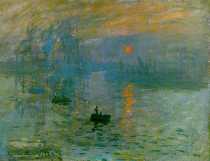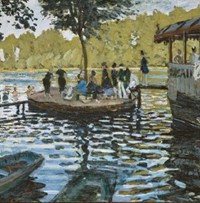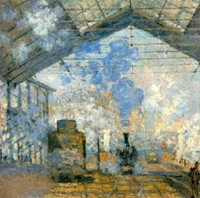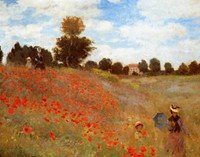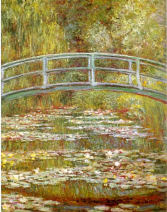|
|
Les Nympheas
(The Waterlilies)
In 1890, Monet was finally able to buy
the house he had been living in at Giverny for the last 7 years. There
was a large garden attached, which he filled with rare plants and flowers,
and a lake with waterlilies, over which he built a little Japanese bridge.
He found here the subject matter for his experiments with 'spontaneity',
something which led him to undertake a great series on a single subject.
At Durand-Ruel's in 1891 he exhibited 13 canvases depicting haystacks
(Meules) and poplars (Peupliers) on the banks of the River
Epte and various aspects of Rouen Cathedral. In July 1982 he married Alice
Raingo, the widow of Ernest Hoschede. In 1894 Cezanne came to live at
the inn at Giverny and, in February 1893, Monet left for Norway where
he spent several months as the guest of Queen Christiana (Mont Colsaas,
Musee d'Orsay). Between the May 10th and May 31st, 1895, he exhibited
50 canvases at Durand-Ruel's, including the 20 views of Rouen Cathedral
and eight canvases painted in Norway.
At the Galerie Georges Petit in 1897 he
exhibited a series of studies of the Nympheas (Waterlilies). See
also: Water
Lily Pond: Green Harmony (1899, National Gallery, London). In
1900 he visited London, where he was often to return, to paint a succession
of canvases of the Thames. On his return, 37 of these were exhibited at
Durand-Ruel's. From a journey to Venice in 1908 he brought back 29 canvases
which were shown in 1912 at the Galerie Bemheim: Le Palais Ducal
(The Ducal Palace) (Brooklyn Museum, New York); Le Grand Canal
(The Grand Canal (Boston Museum of Fine Arts). The 48 landscapes with
water which make up the Nympheas, painted between 1904 and 1906,
and exhibited at Durand-Ruel's between 5th May and 5th June, were highly
successful.
In May 1911 Monet's second wife Alice
died at Giverny. His stepdaughter Blanche Hoschede-Monet, who was herself
a painter, supported Monet by her presence and love until his death.
In 1914 Monet had a large airy studio built
in the grounds at Giverny in order to paint huge canvases on the theme
of the Nympheas (some of these are now in the Musee Marmottan in
Paris). In November 1918, at the instigation of the prime minister, Georges
Clemenceau, he decided to donate to the nation several of these canvases,
in the form of a vast decorative work. The Orangerie at the Tuileries
was chosen as their site. The execution of this immense project was delayed
while Monet underwent a cataract operation, but it was completed before
he died on 5th December 1926. It was unveiled on 17th May 1927. During
his last years, Monet also painted a series of Weeping Willow trees, in
homage to fallen French soldiers in World War I.
The majority of the studies for the Nympheas
were shown at the Galerie Katia Granoff in 1956 and 1957. These shimmering
pools of colour - almost totally devoid of form - are the true starting
point of abstract art, or at least certain forms of it. They are the logical
outcome of Monet's lifelong devotion to capturing the subjective truth
of nature outdoors. As a result, critics have tended to consider Monet
as one of the precursors of lyrical
abstraction, and in particular of the 'abstract landscape'.
These water lily pictures are among a series
of approximately 250 oil paintings by Monet, which was the main focus
of his artistic output during the last thirty years of his life. In June,
2007, Sotheby's auctioned one of Monet's water lily paintings for £18.5
million, making it the most expensive waterscape in the history
of art.
Leading
Exponent of Pure Impressionism
Monet, like Alfred Sisley and Camille Pissarro,
remained largely devoted to painting landscapes en plein air. But
of the three, he was the greatest exponent of the impressionist painting
method: namely to render the play of light on the surface of objects.
This involved the experimental use of varied often bright colour in order
to express one's visual sensation (or impression) of nature, in landscape
painting and other outdoor artworks, in violation of traditional methods
of painting. His conception and execution makes him one of the great pioneers
of Modern art.
Collections
All the world's best
art museums contain works by Monet: among the most important collections
are those in Paris, notably at the Musee
d'Orsay, the Marmottan Museum (75 canvases bequeathed by the artist’s
son in 1968 or deriving from the de Bellio Collection), and the Orangerie
Museum. Elsewhere, the best works can be seen in the Metropolitan Museum
of Art in New York, the Museum of Fine Arts in Boston, and the Art Institute
of Chicago.
Selected Paintings
- La Rue de la Bavolle in Honfleur (1864)
Museum of Fine Arts, Boston.
- The Picnic (Le dejeuner sur l'herbe) (1865-66) Pushkin Museum, Moscow.
- Women in the Garden (1866) Musee d'Orsay, Paris.
- Terrace at Saint-Adresse (1867) Metropolitan Museum of Art, New York.
- Ice on the Seine near Bougival (1867) Private Collection, France.
- The Luncheon (1868) Stedel Art Institute, Frankfurt-on-Maine.
- Rough Sea at Etretat (c.1868-69) Musee d'Orsay, Paris.
- La Grenouillere (1869) Metropolitan Museum of Art, New York.
- The Beach at Trouville (1870) Wadsworth Atheneum, Connecticut.
- The Road to Louveciennes, Effect of Snow (1870) Private Collection.
- The Thames below Westminster (1871) National Gallery, London.
- Regatta at Argenteuil (c.1872) Louvre, Paris.
- The Seine at Bougival (1872) Private Collection.
- The Harbour at Argenteuil (1872) Musee d'Orsay, Paris.
- Poppy Field (1873) Musee d'Orsay, Paris.
- The Luncheon (1873) Musee d'Orsay, Paris.
- Impression: Sunrise (1873) Musee Marmottan Monet, Paris.
- The Boulevard des Capucines (1873) Pushkin Museum of Arts, Moscow.
- The Boulevard des Capucines (1874) Nelson-Atkins Museum of Art.
- Boulevard Pontoise at Argenteuil, Snow (1875) Kunstmuseum, Basel.
- Poplars near Argenteuil (1875) Museum of Fine Arts, Boston.
- Madame Monet in Japanese Costume (1875) Museum of Fine Arts, Boston.
- The Tuileries (1876) Musee Marmottan Monet, Paris.
- Gare St Lazare (1877) Musee d'Orsay, Paris.
- Gare St Lazare: The Train from Normandy (1877) Art Institute of Chicago.
- The Road to Vetheuil (1879) The Art Museum, Goteborg.
- Bank of the Seine, Vetheuil (1880) National Gallery of Art, Washington
DC.
- Monet's Garden at Vetheuil (1881) National Gallery of Art, Washington
DC.
- Tulip Fields in Holland (1886) Musee d'Orsay, Paris.
- The Fields of Poppies (c.1887) The Hermitage, St. Petersburg.
- Haystack, Snow Effects, Morning (1890) National Gallery of Scotland.
- Haystack at Sunset (1891) Museum of Fine Arts, Boston.
- Rouen Cathedral at Twilight (1894) Museum of Fine Arts, Boston.
- Rouen Cathedral in the Evening (1894) Pushkin Museum, Moscow.
- The Seine at Giverny, Morning Mists (1897) North Carolina Museum of
Art.
- White Water Lilies (1899) Pushkin Museum of Fine Arts, Moscow.
- Waterlily Pond (1899) National Gallery, London.
- Water Lily Pond: The Japanese Bridge (1899) Philadelphia Museum of Art.
- Water Lily Pond: Pink Harmony (1900) Musee d'Orsay.
- Vetheuil, Setting Sun (1901) Musee d'Orsay, Paris.
- Houses of Parliament, London (1905) Musee Marmottan Monet, Paris.
- Venice. The Doge's Palace (1908-12) Kunsthaus, Zurich.
- Palazzo da Mula. Venice (1908) National Gallery of Art, Washington DC.
- Water-Lilies (1914) National Museum of Western Art, Tokyo.
- Yellow and Lilac Water Lilies (1914-17) Toledo Museum of Art, Ohio.
- Water-Lilies (1917-20) Musee Marmottan Monet, Paris.
|

